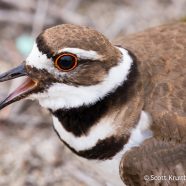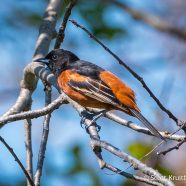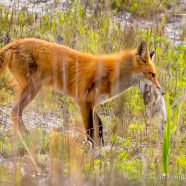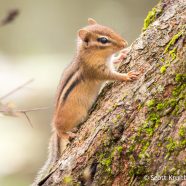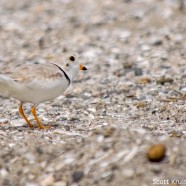Killdeer
I finally got around to editing these photos of a Killdeer (Charadrius vociferus) taken during the Noble Proctor BioBlitz Challenge last month. The bird appeared in the first photo like any other – no big deal. Oh no, this bird is “injured”! Not so much. This is a distraction display, feigning injury, in order to draw our group away from the area and protect a nest or young hatchlings. The bird makes it look like it has a broken wing and has lost the ability to fly, attempting to tempt mammals like us into running them down for a meal (before they fly away). If we did then...
Read MoreOrchard Oriole
This adult male Orchard Oriole (Icterus spurius) is a Stratford Point resident, deftly avoiding our cameras for the most part while feeding mostly in the canopy. Occasionally he drops down closer to eye level, and he has been seen copulating with our resident female. It is likely that we will once again have a nesting pair on site. The family grows up quickly though, and even by the end of July this guy may be heading back to Central America. When they are not vocalizing they can be surprisingly inconspicuous. This is probably the best time of year to get some good views of them without...
Read MoreRed Fox and Cottontail
It is terribly ironic that just hours after my colleague, Audubon Connecticut Director of Bird Conservation Patrick Comins, uploaded some lovely cottontail photos to the Audubon Connecticut at Stratford Point page that I found our vixen Red Fox engaged in some hunting early this morning. I felt some eyes on me as I surveyed for avian migrants along Prospect Drive, and she was watching me from within our side of the fence. This is nothing abnormal, and the interaction was typical – a little curious stare down at one another before we both continue on. However, she then put her attention...
Read MoreYoung Chipmunk
This adorable little Eastern Chipmunk (Tamias striatus) liked me enough to stay on its tree and say hi for a minute before dashing back down underground. Now if this young one would only please remember to stay out of most of these trees and bushes when it grows up because I would rather it choose food other than young birds or eggs from nests each spring. Thanks in advance, pal! Scott Kruitbosch Conservation & Outreach Coordinator
Read More2015 Waterbird Results
The Connecticut Department of Energy and Environmental Protection’s Wildlife Division (CT DEEP) has now released the official nesting results for the state-threatened Least Tern and the federally-threatened Piping Plover from the 2015 monitoring season, and the Audubon Alliance for Coastal Waterbirds (AAfCW) – Audubon Connecticut and the Roger Tory Peterson Institute of Natural History – has completed our American Oystercatcher report. The first bit of fantastic news is that we hosted a new all-time high number of Piping Plover pairs in the state with 62 attempting to breed...
Read More



